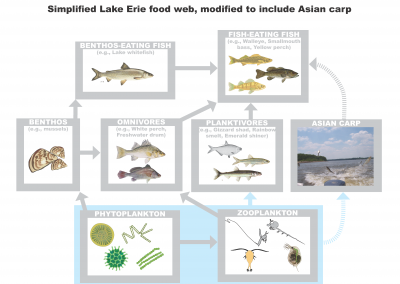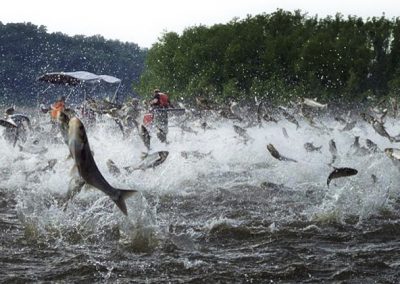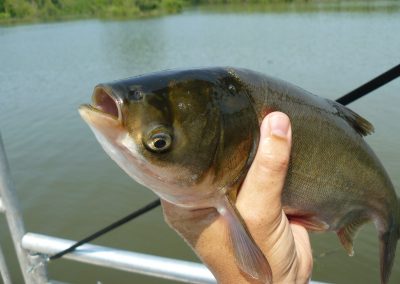Invasive Species
Assessing Risk of Asian Carp Invasion and Impacts on Great Lakes Food Webs and Fisheries
Overview & Objectives
Impacts of Asian Carp on aquatic food webs are potentially complex, and require spatially-explicit models of trophic interactions to assess direct and indirect influences. A spatially-explicit modeling approach allows a more detailed look at the effects of Asian carps on key members of the food web, and allows for the inclusion of density-dependent feedbacks (e.g., lower survival of age-0 fish, but higher growth and reproductive output by older survivors) which may help species compensate for the effects of an Asian carp invasion.
Bighead (Hypophthalmichthys nobili) and silver (H. molitrix) carp (Asian carps) threaten to invade the Great Lakes and disrupt aquatic food webs and fisheries through their consumption of lower trophic levels. In river and lake ecosystems in North America, Asia and Europe, the introductions of Asian carps have resulted in the decline of many native fish species, with planktivorous fish and fish with planktivorous stages being particularly affected (e.g., Arthur et al. 2010; Pegg et al. 2009).
Preliminary studies suggest that Asian carps will have limited distribution and impacts on Great Lakes ecosystems. Cooke et al. (2009) conducted feeding studies on bighead carp at a range of temperatures and zooplankton densities, and found carp grew only at higher zooplankton densities that are found only in limited areas of the Great Lakes. Cooke and Hill (2010) used a bioenergetics model to predict growth of Asian carps in up to 6 areas within each Great Lake given site-specific data on water temperature, and zooplankton and phytoplankton densities. Cooke and Hill (2010) found that silver and bighead carp would be unable to grow in most open-water regions, but would likely be able to grow in many of the embayments and wetlands along the edges of the Great Lakes. Herborg et al. (2007) used environmental niche modeling to predict invasion routes and distributions of Asian carps, and identified near shore environments of Lake Ontario as suitable habitats.
While we generally agree with the approach taken by Cooke and Hill (2010) and Herborg et al. (2007), we believe it is important to take a much more detailed look at the potential for Asian carps to survive, grow and impact other fish species and food webs at additional locations throughout the Great Lakes Basin. For example, water temperatures and the densities of phytoplankton and zooplankton are known to vary substantially throughout the water column and across space and time. Using a single set of numbers to represent environmental conditions at a location will miss many of those details, and may result in a region being incorrectly identified as uninhabitable by Asian carps. Moreover, very few studies have been conducted to document Asian carp impacts on other fishes or fisheries (Sampson et al. 2009). Impacts of Asian carps on aquatic food webs are potentially complex, and require spatially-explicit models of trophic interactions to assess direct and indirect influences. A spatially-explicit modeling approach allows for a more detailed look at the effects of Asian carps on key members of the food web, and allows for the inclusion of density-dependent feedbacks (e.g., lower survival of age-0 fish, but higher growth and reproductive output by older survivors) which may help species compensate for the effects of an Asian carp invasion.
Our objectives are to:
1. Predict in which Great Lakes habitats Asian carps can successfully grow, survive and reproduce.
2. Predict Asian carps’ impacts on food webs, key fish species and fisheries in different Great Lakes environments.
3. Survey the Chinese literature for relevant information on Asian carps’ energetics, vital rates and ecology Outcomes: This work will expands on the results of Cooke and Hill (2010) and helps identify regions in Lakes Huron, Michigan and Erie that could support Asian carps. Our individual-based model and food web model will identify the species and fisheries that likely will be impacted by Asian carps.
Publications
Presentations
Ivan, L., *Rutherford, E., Mason, D., Zhang, H., Hunter, T., Hoff, M. An Individual-based bioenergetics model forecast of Silver and Bighead Carp establishment likelihood and impact in Saginaw Bay, Lake Huron and Lake Erie. The 2nd Mississippi-Yangtze River Basins Symposium (MYRIBS) & the 2015 China Society of Fisheries Resources and Environment Annual Meeting. Wuhan, China, Oct 12-17, 2015.
Zhang, H., Rutherford, E.S., Mason, D.M., Lodge, D., Zhu, X., Johnson, T., and Shakoor, A. Potential impacts of Asian Carp on Great Lakes’ food webs. Yangtze River Fisheries Research Institute, Chinese Academy of Fishery Sciences, Wuhan, China, Oct 20, 2015.
Zhang, H., Ivan, L., Rutherford, E., and Mason, D. Impacts of invasive species in the Great Lakes. Institute of Oceanology, Chinese Academy of Sciences, Qingdao, China. August 28, 2015
Zhang, H., Ivan, L., Rutherford, E., and Mason, D. Impacts of invasive species in the Great Lakes. China Institute of Water Resources and Hydropower Research, Beijing, China. August 14, 2015
Rutherford, E. S., Zhang, H., Kao, Y-C., Adlerstein, S., and Mason, D. M. Ecosystem forecasting in the Great Lakes. Shanghai Ocean University, Shanghai, China. Oct. 20, 2015.
Rutherford, E. S., Zhang, H., Ivan, L. N., Kao, Y-C, Adlerstein, S., and Mason, D. M. Ecosystem forecasting of nutrient loadings and invasive species effects on Great Lakes food webs and fisheries. Yangtze River Fisheries Research Institute, Chinese Academy of Fishery Sciences, Wuhan, China, Oct 19, 2015.
Martinez, F., Rutherford, E. S., Zhang, H., Ivan, L. N., and Mason, D. M. Assessing the potential for Bighead and Silver Carp to establish and effect Great Lakes food webs. Aquatic Nuisance Species Task Force Meeting, Traverse City, Michigan. May 5, 2016.
Resources
• Press release: http://ns.umich.edu/new/releases/23386-asian-carp-could-cause-some-lake-erie-fish-to-decline-others-to-increase • Relevant website: http://www.regions.noaa.gov/great-lakes/?page_id=787 • Circle of Blue, 1-7-16: http://www.circleofblue.org/waternews/2016/great-lakes/asian-carp-would-significantly-alter-but-not-destroy-lake-erie-fisheries/ • Sandusky Register, 1-6-16: http://www.sanduskyregister.com/Environment/2016/01/06/Report-Asian-carp-could-become-dominant-Lake-Erie-fish.html?ci=stream&lp=9&p=2 • Newsweek, 1-6-16: http://www.newsweek.com/asian-carp-could-take-one-third-lake-erie-biomass-412070 • Christian Science Monitor, 1-5-16: http://www.csmonitor.com/Environment/2016/0105/Lake-Erie-Asian-carp-How-great-a-threat-to-Great-Lakes • Washington Post, 1-5-16: www.washingtonpost.com/news/speaking-of-science/wp/2016/01/05/invasive-asian-carp-could-overtake-lake-erie-study-finds/ • Chicago Tribune (Washington Post story), 1-5-16: http://www.chicagotribune.com/news/plus/ct-asian-carp-lake-erie-20160105-story.html • Toledo Blade, 1-5-16: http://www.toledoblade.com/local/2016/01/05/Report-sounds-alarm-of-Asian-carp-threat.html • Michigan Radio Network, 1-5-16: http://michiganradionetwork.com/u-m-study-says-asian-carp-impact-on-lake-erie-would-be-mixed/ • Associated Press, 1-4-16 (appeared in >150 publications): http://www.kansascity.com/news/nation-world/article52929800.html • Milwaukee Journal Sentinel, 1-4-16: http://www.jsonline.com/news/wisconsin/asian-carp-would-dominate-lake-erie-biomass-study-finds-b99645732z1-364188621.html • Detroit News, 1-4-16: http://www.detroitnews.com/story/news/local/michigan/2016/01/04/asian-carp-great-lakes/78253352/ • Great Lakes Echo, 1-28-16: http://greatlakesecho.org/2016/01/28/ecological-casualties-winners-and-losers-in-the-war-on-carp/ • CSCOR Great Lakes Aquatic Habitat Classification website: http://ifrgis.snre.umich.edu/projects/CSCOR/cscor.shtml
PrincipaI Investigator(s):
Hongyan Zhang (CILER)
Dmitry Beletsky (CILER)
NOAA Technical Lead(s):
Ed Rutherford (NOAA-GLERL)
Simplified Lake Erie food web, modified to include invasive Carp. Invasive carp could affect the Lake Erie food web in two ways: by competing with native fish by eating their food and becoming food for other predatory fish. Graphic Credit: Hongyan Zhang, CIGLR Research Scientist.
When frightened, Bighead and Silver varieties of invasive carp can jump up to 10 feet out of the water. Photo Credit: AP Photo/Illinois River Biological Station via the Detroit free Press, Nerissa Michaels.



